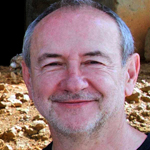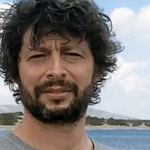Sources of the Krężniczanka river near Bełżyce, Poland
4th place in Biotope Aquarium Design Contest 2018
![]() Poland. Bartłomiej Paśnik
Poland. Bartłomiej Paśnik

Volume: 150 L
Dimensions: 100x50x30 cm
List of fishes: Gasterosteus aculeatus, Lymnaea stagnalis, Nepa cinerea, Trichoptera, Ischnura sp.
List of plants: Veronica sp.
Description of decorations: Elements of decoration came from nature, sand, mud, deadwood. The imitation of the source is powered by a small pump.
Description of equipment: Filtration: Aquael FZN 3 1200 lph, lighting: 30W led 6500k, 10W LED 8000k.
Water parameters: Water temperature is 17-19°C, hardness is 25°dH and the pH is 7.5.
INFORMATION ABOUT BIOTOPE
Description of the area surrounding the biotope: The river in Lublin Voivodeship, which is the left tributary of the Bystrzyca river. It flows between the villages Zagórze and Krężnica. Then it takes a turn and heads east to the city of Bełżyce, in the village of Babin it begins to meander strongly and helps to create picturesque landscapes. The river is over 20 km long and ends its course near Lublin, affecting the marshy area to the Bystrzyca river. The described biotope is located on the outskirts of the city of Belżyce, surrounded by meadows. It is a small lake (Limnokren) with a size of 3×4 m and a depth of about 2 m. Limnokren ( “limno” is for source, and “kren” is for lake) is a type of source characterized by the fact that the flowing underground water accumulates in a small basin, creating a small reservoir of water.
Description of the underwater landscape of the biotope: The bottom of the source is sand, dead wood and small limestone and vegetation. Crystal water with low and constant temperature flows from the ground. The only fish that have been observed are Gasterosteus aculeatus.
Description of the parameters of the habitat: The temperature is constant both in summer and winter 11°C, 25°dH, pH is 7,5.
List of fishes and invertebrates occurring in the nature biotope: Gasterosteus aculeatus, Lymnaea stagnalis, Nepa cinerea, Trichoptera, Ischnura sp.
List of plants found in the nature biotope: Callitriche palustris, veronica sp.
Threats to the ecology: The river was severely polluted in the 1980s and 1990s, leading to the complete extinction of Astacus astacus and Pseudanodonta complanata. Unfortunately, all the time Krezniczanka is exposed to the negative impact caused by humans, littering or flushed fertilizers from nearby fields negatively affect this small ecosystem.
Sources of information:
https://pl.wikipedia.org/wiki/
https://pl.wikipedia.org/wiki/
https://www.google.pl/maps/
Comments of the members of the jury of Biotope Aquarium Design Contest 2018

This aquarium looks similar with the river that you try to imitate. Just l would like to see different plants from this habitat. If you were collecting some different plants from this river and adapting them to your biotope, it would be better. Still this biotope looks natural enough. I liked the bottom part of your biotope. Your fishes and species are really interesting and nice. General looking is average for me. Congrats.

The scene in the aquarium looks like it was taken from a small stream. The only thing that bothers me is I cannot make the connection between images showed on video and those in the aquarium. In the aquarium, it looks like a small stream, and in the description, we can see that depth is around 2 m. But it seems to me that biotope is correct, just the description should be made better.

Few “coldwater” freshwater species can be properly housed in average size aquariums because of their size, but Sticklebacks can, and they are under-represented as a biotope species, and fascinating to own and watch. I like how the owner collected aquascaping materials from nature and feels to me like they know the natural habitat well.
Perfect example of natural habitat which looks like best “aquascapes”. Conclusion – you don’t need to create “underwater gardens”, because you can find beautiful compositions in the wild! And as always, I like when it’s a lot of space and not too many fish.

It is a wonderful example that there are beautiful biotopes in Europe too, and that it is absolutely worth to create a tank in such a style. It is a very good combination of fish and invertebrates, a showy tank that reflects a natural biotope in a sensible and very fine way.

An aquarium that from the first sight gives the impression of an underwater photography of the nature biotope. The arrangement of the vegetation, presence of detritus, as well as of the driftwood and the play with the space in the centre giving depth, allow to obtain a good result. I would have appreciated a little more light at the sides of the aquarium, but overall it’s a great job. Congratulations!

This biotope shows an outstanding level of detail in replicating the area it is based on. The lush stands of aquatic plants appear to have sprouted organically from among the fallen twigs and branches. The way the woody debris follows the line of the current, and the fine dusting of organic detritus on all surfaces, add to the realism. Springs bubble up from beneath the sand, exactly as in the habitat. The slight clearing in the middle allows swimming space for the sticklebacks and also serves as a kind of voyeuristic window into this secret space, as though we are peeking into it unobserved. The schooling-while-foraging behaviour of the sticklebacks is testament to how convincingly authentic it is. Including the invertebrate inhabitants gives the impression of a complete, functioning ecosystem. Of course, there is also an element of risk in this since both species of water scorpion may prey upon the sticklebacks; however, it cannot be denied that they are an omnipresent element in the wild biotope.

This entry has everything you need for a high place in the competition. Stylish design, exact biotopeness, simple clear forms. At the same time, the solution with horizontal branches is quite daring. Creating good design using simple tools is an art.

Simple but effective, nice light composition. Good job!
